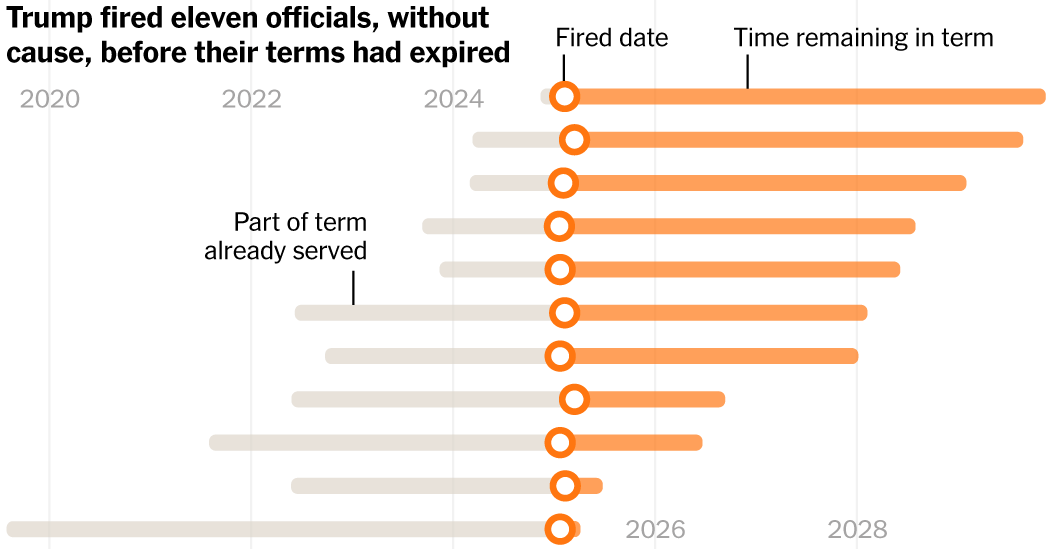Table of Contents
President Trump summarily dismissed more than a dozen members of independent oversight bodies during his first two months in office, defying typical procedures and federal laws that say presidents cannot remove certain officials without good cause, like misconduct or neglect.
The targeted firings of these officials, which have resulted in multiple legal challenges, are part of Mr. Trump’s strategy to prompt the conservative Supreme Court to decide whether a president can remove members of certain independent agencies at will. The Supreme Court on Thursday agreed, for now, to allow Mr. Trump to remove the leaders of two independent agencies who had filed suits contesting their firings.
If the court were to eventually side with Mr. Trump, it could grant a president the authority to dismiss members of independent commissions and boards without cause or explanation — and almost certainly imperil the independence of these bodies. The majority of the court appeared to make an exception for the Federal Reserve Board.
“There is a potential for a government that is devoid of a lot of the checks and balances that we have come to rely on,” said Sharon Block, a professor at Harvard Law School and a former member of the National Labor Relations Board, one of the agencies Mr. Trump has targeted.
Out of the 13 targeted firings, nine members of independent boards and two leaders of independent watchdog agencies, each represented below by a bar, were fired before their terms had expired.
Federal Trade Commission
U.S. Office of Government Ethics
U.S. Office of Special Counsel
National Labor Relations Board
Equal Employment Opportunity Commission
Merit Systems Protection Board
Privacy and Civil Liberties Oversight Board
Federal Labor Relations Authority
Note: In some cases, members can serve in their positions for additional time if a successor has not yet been confirmed; that additional time is not shown here.
Two officials whose terms had already expired remained on their boards for additional time, as allowed by law if a successor had not yet been selected. Although Mr. Trump had not nominated successors, he fired them anyway. (One official was removed just a few days before the end of her additional allotted time).
Although members of these independent bodies are in most cases appointed by the president and confirmed by the Senate, they were intended by Congress to be insulated from political interference and retaliation.
For one, these independent commissions and boards are often required, by statute, to have a bipartisan makeup. Members, in many cases, serve staggered terms of longer than four years, in part so no one president can replace many members all at once.
Mr. Trump, however, has largely taken aim at Democratic officials or officials selected by Democratic administrations. The firings hobbled at least four independent bodies, leaving them without the quorum needed to take official actions.
Trump at one point left four independent bodies without quorum
Note: The makeup of each agency immediately after the firings is shown here, and it does not reflect any court cases requiring members to be temporarily reinstated or members appointed after the firings.
One of the hobbled entities, the Merit Systems Protection Board, is at the center of the administration’s efforts to rapidly downsize the civil service. The board hears appeals from federal employees on unfair personnel practices, including wrongful termination.
Mr. Trump also fired and replaced the U.S. special counsel, whose office had led a legal challenge on the administration’s mass termination of probationary workers. That office in April dropped its inquiry into more than 2,000 complaints that the Trump administration had improperly fired probationary employees.
The Trump administration has also targeted other watchdogs across the federal government, abruptly firing 18 inspectors general without cause or proper notice.
Although inspectors general have fewer protections than members serving on independent commissions, a president is legally required to give Congress 30 days’ advance notice before removing any inspector general, alongside detailed and case-specific reasoning for the removal.

